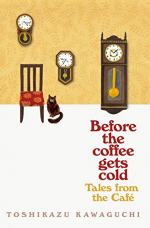
|
| Name: _________________________ | Period: ___________________ |
This test consists of 5 short answer questions, 10 short essay questions, and 1 (of 3) essay topics.
Short Answer Questions
1. How many times did the man ask Kazu to be his girlfriend before she agreed?
2. When Gohtaro returns to the present, what is the first thing that he wants to do?
3. What kind of drawing does Kazu specialize in?
4. After Kyoko leaves, who is in the café with Kazu?
5. Where did Haruka meet Satoshi Obi?
Short Essay Questions
1. What happens to Gohtaro physically when Kazu pours the coffee?
2. What are the rules of the time-traveling café?
3. Why does Kazu sound stern when she tells Gohtaro, "You know that even if your return to the past, reality won't change, right?" (13)?
4. How did Gohtaro end up raising Shuichi's daughter?
5. Why does the narrator use vague language to describe the tears falling during the encounter between Shuichi and Gohtaro?
6. What does Kyoko reveal about her brother's reaction to their mother's death?
7. Before Gohtaro goes into the past, what is his plan to deal with the revelations that will occur upon Haruka's marriage?
8. What causes the narrator to suggest that Kyoko might be thinking, "Saved by Miki" when Kyoko suddenly bursts out laughing on page 53?
9. What rule of time traveling in the café does Gohtaro almost immediately break when he returns to the past, and who saves him from this error?
10. When Gohtaro first sees Shuichi in the past, why does the gesture of putting his hand around his coffee cup cause Gohtaro to suddenly panic about his own ability to communicate?
Essay Topics
Write an essay for ONE of the following topics:
Essay Topic 1
How does the repeated structure of the stories in Tales from the Café impact the collection's tone? What impact do predictability and familiarity have on the reader? How would the feeling the reader gets from these stories be different if each story had a very different, perhaps more challenging, structure? The repeated elements of structure are perhaps most noticeable in the passages where the customers are actually traveling through time and returning to the present. Why do you think this is--what clues to intended tone do you see in the language and details in these passages? Write an essay in which you analyze the impact of the stories' repeated structures on the tone of Tales from the Café. Support your assertions with evidence drawn from throughout the text, and be sure to cite any quoted evidence in MLA format.
Essay Topic 2
The relationship between Yukio and his mother is one of mutual obligation to each other's happiness. This relationship gives their lives meaning, and their obligations to one another do not end with either's death. How does the relationship between Kazu and Kaname echo this relationship? What other kinds of relationships does the text present similarly, as a two-way system of obligation that transcends death? Write an essay in which you consider the text's messages about mutual obligation in intimate human relationships. Support your assertions with evidence drawn from throughout the text and be sure to cite any quoted evidence in MLA format.
Essay Topic 3
Do some more research into the uses of ghosts in Japanese literature. Now that you are aware of the identity of the ghost in Tales from the Café, what points about family relationships and mutual obligations would you say are being made through her appearance--and through her eventual disappearance? What do these ideas convey about the nature of happiness? Use your research and evidence from the collection to write an essay in which you analyze the thematic significance of Kaname's ghost in Tales from the Café. Be sure to cite any quoted evidence in MLA format.
|
This section contains 1,288 words (approx. 5 pages at 300 words per page) |

|




